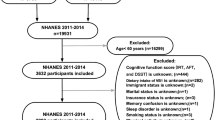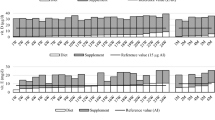Abstract
Objectives:
To describe the intake of vitamins thiamine (B1), riboflavin (B2), B6 (pyridoxine), B12 (cobalamine) and C (ascorbic acid) and their food sources among 27 centres in 10 countries participating in the European Prospective Investigation into Cancer and Nutrition (EPIC) study.
Methods:
Between 1995 and 2000, 36 034 persons aged between 35 and 74 years were administered a standardized 24-h dietary recall using a computerized interview software programme (EPIC-SOFT). Intakes of the four B vitamins and vitamin C were estimated using the standardized EPIC Nutrient Database (ENDB). Mean intakes were adjusted for age and weighted by season and day of recall.
Results:
Intake of B vitamins did not vary considerably between centres, except in the UK health-conscious cohort, in which substantially higher intakes of thiamine and lower intakes of vitamin B12 were reported compared with other centres. Overall, meat was the most important contributor to the B vitamins in all centres except in the UK health-conscious group. Vitamin C showed a clear geographical gradient, with higher intakes in the southern centres as compared with the northern ones; this was more pronounced in men than in women. Vegetables and fruits were major contributors to vitamin C in all centres, but juices and potatoes were also important sources in the northern centres.
Conclusions:
This study showed no major differences across centres in the mean intakes of B vitamins (thiamine, riboflavin, B6, B12), whereas a tendency towards a north–south gradient was observed for vitamin C.
This is a preview of subscription content, access via your institution
Access options
Subscribe to this journal
Receive 12 print issues and online access
$259.00 per year
only $21.58 per issue
Buy this article
- Purchase on SpringerLink
- Instant access to full article PDF
Prices may be subject to local taxes which are calculated during checkout



Similar content being viewed by others
References
Alexander J, Anderssen SA, Aro A, Becker W, Fogelholm M, Lyhne N et al. (2004). Nordic Nutrition Recommendations. Nordic Council of Ministers: Copenhagen.
Balk E, Chung M, Raman G, Tatsioni A, Chew P, Ip S et al. (2006). B vitamins and berries and age-related neurodegenerative disorders. Evid Rep Technol Assess 134, 1–161.
Brustad M, Skeie G, Braaten T, Slimani N, Lund E (2003). Comparison of telephone vs face-to-face interviews in the assessment of dietary intake by the 24 h recall EPIC SOFT program--the Norwegian calibration study. Eur J Clin Nutr 57, 107–113.
Davey GK, Spencer EA, Aplleby PN, Allen NE, Knox KH, Key TJ (2003). EPIC-Oxford: lifestyle characteristics and nutrient intakes in a cohort of 33 883 meat-eaters and 31 546 non meat-eaters in the UK. Public Health Nutr 6, 259–269.
Ferrari P, Kaaks R, Fahey MT, Slimani N, Day NE, Pera G et al. (2004). Within- and between-cohort variation in measured macronutrient intakes, taking account of measurement errors, in the European Prospective Investigation into Cancer and Nutrition study. Am J Epidemiol 160, 814–822.
Friedenreich C, Cust A, Lahmann PH, Steindorf K, Boutron-Ruault MC, Clavel-Chapelon F et al. (2007). Physical activity and risk of endometrial cancer: the European Prospective Investigation into Cancer and Nutrition. Int J Cancer 121, 347–355.
Haftenberger M, Lahmann PH, Panico S, Gonzalez CA, Seidell JC, Boeing H et al. (2002a). Overweight, obesity and fat distribution in 50- to 64-year-old participants in the European Prospective Investigation into Cancer and Nutrition (EPIC). Public Health Nutr 5 (Suppl), S1147–S1162.
Haftenberger M, Schuit AJ, Tormo MJ, Boeing H, Wareham N, Bueno-de-Mesquita HB et al. (2002b). Physical activity of subjects aged 50–64 years involved in the European Prospective Investigation into Cancer and Nutrition (EPIC). Public Health Nutr 5 (Suppl), 1163–1176.
Huang HY, Caballero B, Chang S, Alberg A, Semba R, Schneyer C et al. (2006a). Multivitamin/mineral supplements and prevention of chronic disease. Evid Rep Technol Assess 139, 1–117.
Huang HY, Caballero B, Chang S, Alberg AJ, Semba RD, Schneyer CR et al. (2006b). The efficacy and safety of multivitamin and mineral supplement use to prevent cancer and chronic disease in adults: a systematic review for a National Institutes of Health state-of-the-science conference. Ann Intern Med 145, 372–385.
Jacob RA, Sotoudeh G (2002). Vitamin C function and status in chronic disease. Nutr Clin Care 5, 66–74.
Kaaks R, Plummer M, Riboli E, Esteve J, van Staveren W (1994). Adjustment for bias due to errors in exposure assessments in multicenter cohort studies on diet and cancer: a calibration approach. Am J Clin Nutr 59 (Suppl), S245–S250.
Kaaks R, Riboli E, van Staveren W (1995). Calibration of dietary intake measurements in prospective cohort studies. Am J Epidemiol 142, 548–556.
Kirk SF, Case JE, Barrett JH, Conner M (1999). Diet and lifestyle characteristics associated with dietary supplement use in women. Public Health Nutr 2, 69–73.
Li Y, Schellhorn HE (2007). New developments and novel therapeutic perspectives for vitamin C. J Nutr 137, 2171–2184.
Lyle BJ, Mares-Perlman JA, Klein BE, Klein R, Greger JL (1998). Supplement users differ from non-users in demographic, lifestyle, dietary and health characteristics. J Nutr 128, 2355–2362.
Margetts BM, Pietinen P (1997). European Prospective Investigation into Cancer and Nutrition: validity studies on dietary assessment methods. Int J Epidemiol 26 (Suppl 1), S1–S5.
Powers HJ (2003). Riboflavin (vitamin B-2) and health. Am J Clin Nutr 77, 1352–1360.
Riboli E, Kaaks R (1997). The EPIC Project: rationale and study design. European Prospective Investigation into Cancer and Nutrition. Int J Epidemiol 26 (Suppl 1), S6–S14.
Riboli E, Hunt KJ, Slimani N, Ferrari P, Norat T, Fahey M et al. (2002). European Prospective Investigation into Cancer and Nutrition (EPIC), study populations and data collection. Public Health Nutr 5 (Suppl), S1113–S1124.
Ruano-Ravina A, Figueiras A, Freire-Garabal M, Barros-Dios JM (2006). Antioxidant vitamins and risk of lung cancer. Curr Pharm Des 12, 599–613.
Schröder H, Marrugat J, Elsosua R, Covas MI (2002). Tobacco and alcohol consumption: impact on other cardiovascular and cancer risk factors in a southern European Mediterranean population. Br J Nutr 88, 273–281.
Skeie G, Braaten T, Hjartåker A; Lentjes M, Amiano P, Jakszyn P et al. (2009). Use of dietary supplements in the European Prospective Investigation into Cancer and Nutrition calibration study. Eur J Clin Nutr 63 (Suppl 4), S226–S238.
Slimani N, Deharveng G, Charrondiere RU, van Kappel AL, Ocke MC, Welch A et al. (1999). Structure of the standardized computerized 24-h diet recall interview used as reference method in the 22 centers participating in the EPIC project. European prospective investigation into cancer and nutrition. Comput Methods Programs Biomed 58, 251–266.
Slimani N, Deharveng G, Unwin I, Southgate DA, Vignat J, Skeie G et al. (2007). The EPIC nutrient database project (ENDB). a first attempt to standardize nutrient databases across the 10 European countries participating in the EPIC study. Eur J Clin Nutr 61, 1037–1056.
Slimani N, Fahey M, Welch AA, Wirfalt E, Stripp C, Bergstrom E et al. (2002b). Diversity of dietary patterns observed in the European Prospective Investigation into Cancer and Nutrition (EPIC) project. Public Health Nutr 5 (Suppl), S1311–S1325.
Slimani N, Ferrari P, Ocke M, Welch A, Boeing H, Liere M et al. (2000). Standardization of the 24-h diet recall calibration method used in the European Prospective Investigation into Cancer and Nutrition (EPIC): general concepts and preliminary results. Eur J Clin Nutr 54, 900–917.
Slimani N, Kaaks R, Ferrari P, Casagrande C, Clavel-Chapelon F, Lotze G et al. (2002a). European Prospective Investigation into Cancer and Nutrition (EPIC) calibration study: rationale, design and population characteristic. Public Health Nutr 5 (Suppl), S1125–S1145.
Spinneker A, Sola R, Lemmen V, Castillo MJ, Pietrzik K, Gonzalez-Gross M. (2007). Vitamin B6 status, deficiency and its consequences--an overview. Nutr Hosp 22, 7–24.
WCRF/AICR (2007). Food, Nutrition, Physical Activity, and the Prevention of Cancer: A Global Perspective. World Cancer Research Fund/American Institute for Cancer Research: Washington DC.
WHO/FAO (2004). Vitamin and Mineral Requirements in Human Nutrition, 2 edn. World Health Organization/Food and Agriculture Organization of the UN: Geneva.
Willett WC (1998). Nutr Epidemiol 2nd edn. Oxford University Press: New York.
Wirfalt E, McTaggart A, Pala V, Gullberg B, Frasca G, Panico S et al. (2002). Food sources of carbohydrates in a European cohort of adults. Public Health Nutr 5 (Suppl), S1197–S1215.
www.efsa.europa.eu. (2008): http://www.efsa.europa.eu/EFSA/Scientific_Document/upper_level_opinions_full-part33.pdf.
www.eur-lex.europa.eu (2008) CELEX: 31990L0496.
Acknowledgements
The work described in this paper was carried out with the financial support of the European Commission: Public Health and Consumer Protection Directorate 1993–2004; Research Directorate-General 2005; Ligue contre le Cancer (France); Société 3M (France); Mutuelle Générale de l’Education Nationale; Institut National de la Santé et de la Recherche Médicale (INSERM); Institut Gustave Roussy; German Cancer Aid; German Cancer Research Center; German Federal Ministry of Education and Research; Danish Cancer Society; Health Research Fund (FIS) of the Spanish Ministry of Health; Spanish Regional Governments of Andalucía, Asturias, Basque Country, Murcia and Navarra and the Catalan Institute of Oncology; and ISCIII RETIC (RD06/0020), Spain; Cancer Research UK; Medical Research Council, UK; the Stroke Association, UK; British Heart Foundation; Department of Health, UK; Food Standards Agency, UK; the Wellcome Trust, UK; Greek Ministry of Health; Hellenic Health Foundation; Italian Association for Research on Cancer; Italian National Research Council, Regione Sicilia (Sicilian government); Associazione Iblea per la Ricerca Epidemiologica—ONLUS (Hyblean association for epidemiological research, NPO); Dutch Ministry of Health, Welfare and Sport; Dutch Prevention Funds; LK Research Funds; Dutch ZON (Zorg Onderzoek Nederland); World Cancer Research Fund (WCRF); Swedish Cancer Society; Swedish Research Council; Regional Government of Skane and the County Council of Vasterbotten, Sweden; Norwegian Cancer Society; the Norwegian Research Council and the Norwegian Foundation for Health and Rehabilitation. We thank Sarah Somerville, Nicole Suty and Karima Abdedayem for assistance with editing and Kimberley Bouckaert and Heinz Freisling for technical assistance.
Author information
Authors and Affiliations
Corresponding author
Additional information
Guarantor: A Olsen.Contributors: AO conducted the statistical analysis, prepared tables and wrote the paper, taking into account comments from all co-authors. NS was the overall coordinator of this project and of the EPIC Nutrient Database (ENDB) project. JH, CG, BB, HV, MJ, MB and UE were members of the writing group and gave input on the statistical analysis, drafting of the article and interpretation of results. The other co-authors were local EPIC collaborators who participated in the collection of dietary and other data and in the ENDB project. ER is the overall coordinator of the EPIC study. All co-authors provided comments and suggestions on the article and approved the final version.
Rights and permissions
About this article
Cite this article
Olsen, A., Halkjær, J., van Gils, C. et al. Dietary intake of the water-soluble vitamins B1, B2, B6, B12 and C in 10 countries in the European Prospective Investigation into Cancer and Nutrition. Eur J Clin Nutr 63 (Suppl 4), S122–S149 (2009). https://doi.org/10.1038/ejcn.2009.78
Published:
Issue date:
DOI: https://doi.org/10.1038/ejcn.2009.78
Keywords
This article is cited by
-
Factors associated with serum/plasma concentrations of vitamins A, C, E and carotenoids in older people throughout Europe: the EUREYE study
European Journal of Nutrition (2013)
-
Use of dietary supplements in the European Prospective Investigation into Cancer and Nutrition calibration study
European Journal of Clinical Nutrition (2009)
-
Specific food group combinations explaining the variation in intakes of nutrients and other important food components in the European Prospective Investigation into Cancer and Nutrition: an application of the reduced rank regression method
European Journal of Clinical Nutrition (2009)



